Free Software in the BSI
The Kroupware project is a development that Bundesamt fr
Sicherheit in der Informationstechnik (BSI) of the German government
contracted from a consortium of three companies - Intevation,
Erfrakon and Klar舁vdalens Datakonsult AB.
The project has three parts:
The server has been made by Erfrakon; the client by Klar舁vdalens
Datakonsult AB and Intevation handled project administration. Outlook
compatibility is a shared task between the parts.
BSI wanted to do a move towards free software, both on the client
and on the server. Currently there are no solutions that provide this
completely, although several projects are close.
The solution we presented them is not a new development per se, but
instead an integration of existing parts and projects. Building a
complete groupware solution is an incredibly large job, but by using the
existing parts, we were able to have a working prototype in less than
three weeks.
The Kolab Server
The server built by Erfrakon is a collection of free software
server parts that have been put together to form a complete
groupware server solution. On top of the parts, Erfrakon built a
web administration module.
The server parts are:
Apache Web server
Postfix Mail server
Cyrus Imap server
OpenLDAP LDAP server
Proftpd FTP server
Sieve scripting
A couple of other parts were also used, but these are the main
ones.
The webinterface they built is used to administrate these parts
in an integrated way. For example, adding a user will put the user
information in the addressbook supplied by the LDAP server, it will
make a directory for web access using webdavs (and ftp, if legacy
support is enabled), and so on. Screenshots of the user administration
is given below.
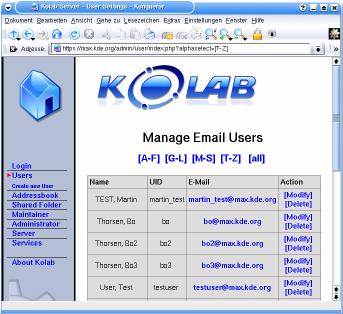
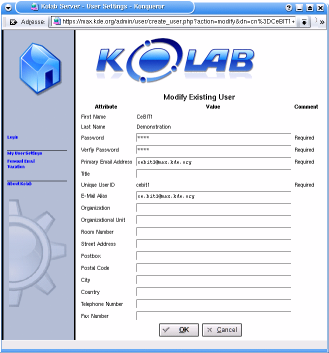
The webinterface also controls the entire server environment. It
is here one can en- or disable services, as shown in the next
screenshot.
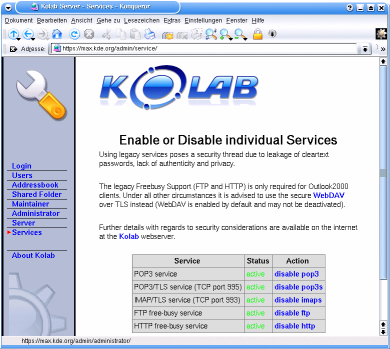
As you can see in the screenshot, ftp is only used for Outlook
2000 compatibility. Using this old and insecure protocol is an
unfortunate necessity when maintainting compatibility with old
legacy software. There are also many places in the client where this
compatibility requirement have meant lots of sidestepping the normal
Outlook approximations to standards.
To make Outlook work with the server, we are using the Bynari
plugin, that enables Outlook to use other servers than Microsoft
Exchange. This plugin is also used in other Kolab like servers.
Currently SuSE and Bynari provides commercial Exchange replacements
that provide functionality akin to Kolab. But Kolab is the only
free software server that does the job.
I will not describe the server in more detail here, but instead
go over the parts as seen from the client view in the discussion
of this.
The KDE Kroupware Client
Where the server parts were easy to determine (setting aside
discussions like which IMAP server should be used), the client was
potentially taken from a larger array of possibilities. Mozilla and
Evolution would be the two other solutions that would have been
fairly easy to get working with Kolab. Yet another possibility would
be to extend an existing webbased groupware solution, but none was
found to be stable enough.
A KDE solution based on KMail was the one that was chosen. Among
the arguments for this was the トgypten project that Intevation,
Klar舁vdalens Datakonsult AB and g10 Code implemented for BSI.
It was decided that the main userinterface would be to have the
KDE calendar application KOrganizer embedded in KMail. Additionally,
the KDE addressbook KAddressbook should be able to access the LDAP
addressbook in the Kolab server. We did not want to rename the
actual parts used, so by now we use KMail, KMKO (abbreviation of
KMail/KOrganizer) or the Kolab client as the term for the application.
The next screenshot shows the main user interface of the client.
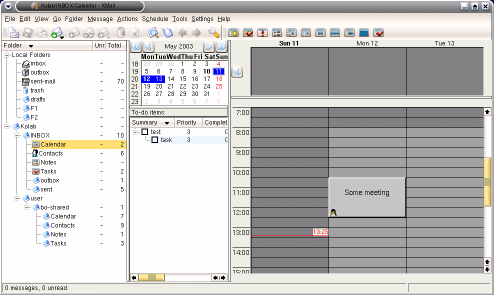
New KMail features
Klar舁vdalens Datakonsult AB and Marc Mutz added a good list
of new features to KMail for the Kroupware project:
In the next sections, I will describe each of these.
The Disconnected IMAP account
Disconnected IMAP - from here on dIMAP - is at the heart of
the Kroupware project, since all user info is stored in IMAP
folders on the server.
dIMAP works by
synchronizing the IMAP server contents to the local disk. The
KMail user will after the sync work on the local cache, and upon
the next synchronization, all local changes will be uploaded to
the server before new mails are downloaded to the local cache. The
basic idea is that after the synchronization, the contents of the
server and the local cache are identical.
The user benefits in this is that you do not have to be
online to go through the mail boxes. It is also an easy way to
make two machines have the same mail setup - for example your
workstation and a laptop.
With the current IMAP implementation in KMail no local cache
is used which means the user must be online while going through
the mail boxes. The biggest user benefit in this is that you local
disk usage is almost zero - not a small benefit if you have
several gigabytes of email.
The future work for dIMAP includes two enhancements:
Selecting a folders to be synchronized, and creating filters for
what will be synchronized.
Folder selection have almost been implemented.
The idea here is that normally you won't
synchronize all folders - users often have old mail archives that
are not often changed.
Synchronization filters is a setup where the user can select
parts of the folders that shouldn't be downloaded to the local
cache (unless explicitly told to do so). Examples include "Don't
cache mails larger than X kb", "Don't cache attachments" and
"Don't cache mails older than two months".
Comparing the two IMAP implementations show that the current
IMAP implementation is almost the same as the behaviour you get
when using a dIMAP implementation with a sync filter set to "Don't
cache anything" and the user deleting the cache after reading a
mail. The current implementation is very handy in the situation
where users have very little disk space available. When this isn't
the case, the dIMAP implementation should prove more
userfriendly.
dIMAP have one other big advantage over normal IMAP. With
this, it's possible to use KMails excellent mail filtering.
The implementation of dIMAP is approaching a very stable
situation, but the HEAD implementation still experiences
crashes. Data loss haven't been seen in testing since november,
but the local cache has been seen to be confused. Advice to people
wanting to use dIMAP is to backup mails they really don't want to
loose. The implementation is definately stable enough for more
thorough testing so we can find the remaining bugs that are
there. Speed-wise, the implementation isn't as effective as it
could be. We have concentrated completely on stability and
sacrificed all speedups we could think of to make the
implementation as stable as it can be. The effect should be that
it's much more stable, but synchronization can take quite a long
time. Later work on this should yield big speedups in the
synchronization.
dIMAP uses the normal KMail maildir for the local cache, so
technically, what we did was to make the synchronization code and
not touch the local storage. This means that the local cache is
just as stable as having normal local maildir folders. At a later
point we hope to decouple the account code completely from the
folder code, so the user can choose which type of folder he wants
as the local cache.
In all KMail screenshots that are here, the folders in the
Kolab account are dIMAP folders. The folders under INBOX are the
private user folders. The folders under shared are shared between
groups of persons - shared folders are set up by the web admin
module
Message Disposition Notification
MDNs - Message Disposition Notifications - are a
generalization of what is commonly called "read receipt". The
message author requests a disposition notification to be sent and
the receiver's mail program generates a reply from which the
author can learn what happened to his message. Common disposition
types include "displayed" (i.e. read), "deleted" and "dispatched"
(e.g. forwarded).
In KMail you can request notification when people read the
mail you sent, and KMail can send notification when you read mail
sent to you with notification requests.
The next screenshots show the dialog you get when opening
an MDN mail, and the returned mail.

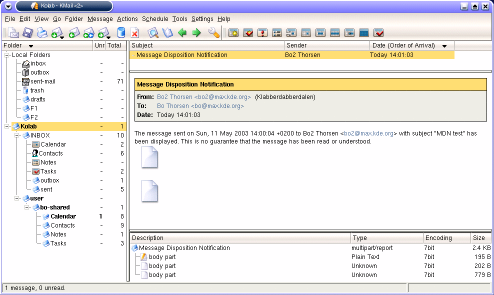
Vacation setup
You can now setup timeframes where you are away from a small
userfriendly dialog in KMail:

Automatic resource scheduling
In groupware mode, you can setup accounts to work as
automatic resource scheduling. With this, you set up accounts for
each resource you want to schedule. An example could be a
room. You make an account that holds the rooms calendar, and
people "invite" the room to a meeting. When KMail receives such an
invitation, it automatically accepts if the resource is free - if
not, it rejects the invitation. We don't mind people calling this
a hack, but it works surprisingly well :-)
IMAP Resource backend to KMail
The new resource framework in kdelibs and kdepim have
different backend implementations. The obvious one is to use the
local disk for the storage, which is the standard
implementation. For the addressbook, there is also an LDAP
backend, and so on.
We have implemented a resource backend in KMail, so this can
be used for storage. This means KOrganizer, KAddressbook and other
applications can save their data in KMail folders. This is
specifically done with dIMAP in mind, so synchronization in
addition to emails also syncs calendar, contacts and notes
KOrganizer connectivity for groupware scheduling
To complete the groupware functionality, code have been
added to KMail to intercept incoming groupware messages.
In KMail, different things happen depending on what is in
the message currently being read. We have added the check for
mimetypes holding calendar related information. When a message
with such a mimetype is seen, the iCal file is given to the
groupware code that reformats it to a HTML message which includes
the choices the user has. So when an invitation arrives, this is
transformed to a message saying you have been invited to a meeting
in XX from YY to ZZ. Below that there are four links with
different options, the most important being accept and
decline. When the user clicks one of these links, KMail will call
KOrganizer code with the message and the user choice. After that
it is up to KOrganizer to put the information into the right
resource (which could be the IMAP resource as described
above). A screenshot of receiving an invitation is shown below.
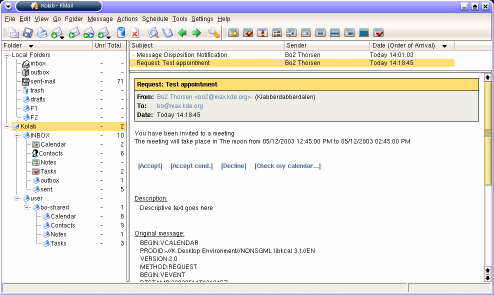
In addition to this, KMail also offers to format and send
the messages from KOrganizer, so correct replies and invitations
are sent. More on this below.
The general split here is that KOrganizer handles all iCal
related, and KMail handles how the iCal is put into mails or read
from mails.
KOrganizer enhancements
Klar舁vdalens Datakonsult AB also did the work on
KOrganizer and the underlying iCalendar libraries to make it
work with the Kolab server inside KMail.
There were basically three things we had to do:
Enhance groupware scheduling
Enable IMAP (KMail) storage
Embed KOrganizer in KMail
KOrganizer already had a kind of groupware scheduling, but
it was missing several features. The most visible of these was
fixed with the addition of a gantt view in the invitation dialog.
A screenshot of this is given below.
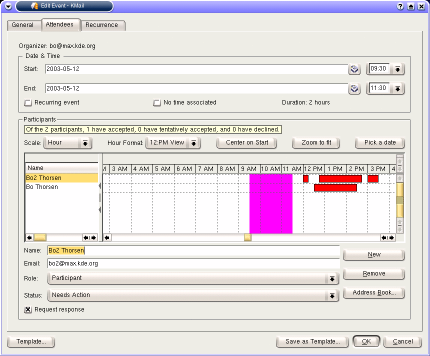
In this screenshot, you can also see the list of people invited,
you have the action that these are expected to take, their roles,
and overview of who have answered what and so on. The gantt view
shows the schedule of each of the participants, with the red boxes
being the busy periods, and the purple vertical bar being the current
time of the meeting. The dialog can automatically find the next
time where all participants are free.
KOrganizer is embedded in KMail using the KParts technology.
This is the component architecture in KDE that enables parts
containers to embed parts inside the user interface. Especially
Konqueror uses this extensively to show different file types.
Not directly visible was all the work that was done on
KOrganizer and the kdepim libraries to make it work with KMail. This
work included answering KMail requests about iCalendar files;
constructing iTIP messages (iCalendar scheduling files) to be sent by
KMail; receiving appointment replies and updates; and using KMail IMAP
folders as the storage.
Other Kdepim Components
Two more applications needed some extra work - KPilot and
KAddressbook. Unlike KOrganizer, these continue to be separate
applications as opposed to run inside KMail.
KPilot is the application that syncs calendar and addressbook
information to Palm Pilot handhelds. This needed to be modified
so it was also able to read everything from the KMail storage.
KAddressbook also got that extra feature. In the Kolab
environment this has a special meaning. The shared addressbook is
shared using LDAP. The entries in the users own Contacts KMail folder
are private entries, where the user can add all contact information.
A screenshot of KAddressbook with some local contacts is shown below.
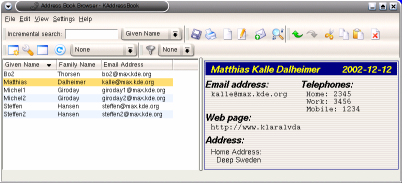
Future Work
In kroupware_branch all this is working, but in cvs HEAD
there are still some issues to be sorted out before this is
working. The difference is that in kroupware_branch, all
communications is done with Qt signals and slots, where in HEAD
it's done with DCOP. This is currently being retrofitted to work
in the Kontact framework and is looking very promising.
Kontact is better designed technically, and will hopefully also
be an even better user experience. Currently the KMail parts of
kroupware have been ported, and the IMAP resource backend have been
reimplemented in the new framework. The missing parts are the
korganizer parts that enable the groupware scheduling. This will
hopefully be done before KDE 3.2.
A screenshot taken by Zack Rusin of Kontact:
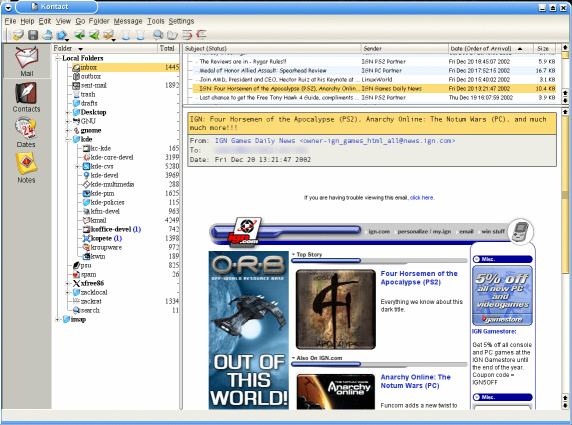
Other future work is to implement a lot more groupware features.
The Kroupware project had a very specific list of features, and there
are plenty more features that we would like to implement.
Another area is that we hope other projects will implement support
for the Kolab server and cooperation with the KDE client. A webbased
solution is currently in it's early beginning, and hopefully Evolution
and Mozilla people will work on this too.
